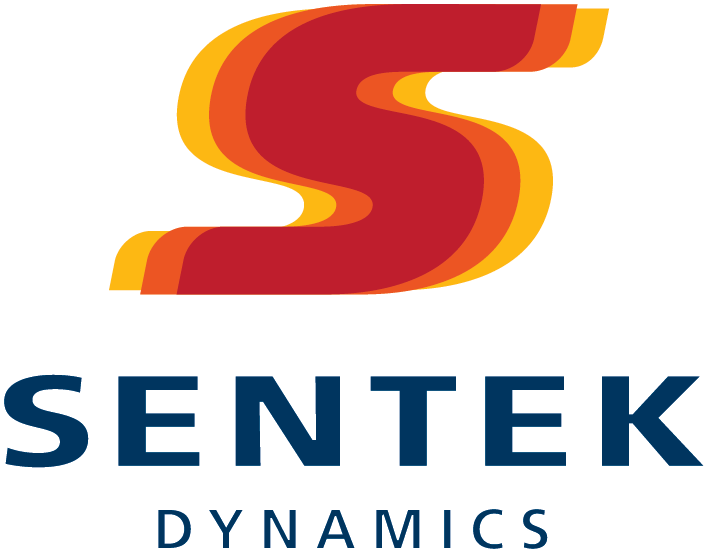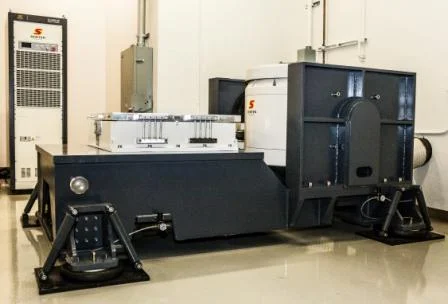This paper discusses the usage and unique features of Multiple-Exciter Single-Axis (MESA) control with Crystal Instruments vibration controller.
MESA is a type of multiple exciter setup with all exciters arranged along a single axis. The goal is to combine the excitation forces and dimensional capabilities from multiple exciters to test a long and/or large Unit Under Test. MIL-STD-810G Method 527 discusses the terminology involving single and multiple exciter testing configurations.
The following sections examine MIMO (Multiple-Input Multiple-Output) and MESA vibration control in detail. MEMA (Multiple-Exciter Multiple-Axis) vibration control completes the trio.
A MIMO vibration test system provides the most complete mathematical descriptions to the controller. Each vibration control type has unique problems to solve.
Reasons to use multiple exciters instead of a single exciter for vibration testing:
3-DOF or multiple-DOF vibration testing provides a more realistic simulation for the UUT compared to single DOF vibration testing.
Large structure testing that cannot be excited with a single shaker without extensive fixturing.
Large structure testing with a single shaker does not provide sufficient force.
Tests that require simultaneous multiple axis excitation (translation only).
Tests that require simultaneous multiple axis excitation with rotation (6-DOF).
MDOF testing is recommended when SDOF testing is inadequate to properly distribute the vibration energy to satisfy the specification.
Reasons to use MESA (Multiple Exciter Single Axis) vibration control:
For a very large structure, testing a single shaker does not provide sufficient force. Two or more shakers are used to achieve the same goal pursued with single shaker excitation.
Major difference between MIMO and MESA vibration control:
MIMO vibration control asks for multiple identical or different target profiles to control while in MESA only one target profile is required.
MIMO vibration control usually has a good mechanical decoupling between different axis while in MESA vibration control the coupling between two or multiple shakers is typically much stronger to resolve.
Multiple-Input Multiple-Output (MIMO) Vibration Control
In general, MIMO vibration control is used for MEMA shaker systems.
A decoupler is located inside the shaker table to physically allow three axis translational motions. MEMA systems require a MIMO vibration controller to achieve control. The following photo of a three-axis shaker system shows three shakers perpendicular to each other. This shaker system is capable of providing vibration simultaneously along X, Y and Z directions.
Three directional shakers can move individually or together along each axis. This allows simultaneous X Y and Z axis testing.
The 6-DOF system is another MEMA system.
The preceding photo displays a 6-DOF shaker system containing eight shakers. Four shakers are arranged vertically, while two shakers each are arranged along the longitudinal and transverse directions. This system is overdetermined from the excitation point of view. There are eight drive DOF compared to the 6-DOF of the shaker table which will be driven by the eight shakers. With MIMO vibration control, the shaker system can be controlled to carry out the corresponding vibration test, i.e., Random, Sine, TWR, etc.
In a typical MIMO vibration test setup, multiple profiles are defined. Each profile has one corresponding control signal. Each control signal comes from the weighted summation of multiple input channels.
The following screenshot displays three control signals with three target profiles in a Random vibration test.
Crystal Instruments MIMO vibration controller uses the transfer function matrix and phase control to achieve control performance.
Multiple-Exciter Single-Axis (MESA) Vibration Control
The following photo displays a dual shaker vertical configuration which can be controlled using MESA vibration control.
Note that the UUT is rigidly mounted on top of bother shaker heads.
Another dual shaker vertical case:
The UUT is mounted on top of double spherical joints to physically allow out of phase motion.
Dual shaker systems are commonly configured as vertical, horizontal push-push, or horizontal push-pull.
One unique feature of MESA vibration control is the ability to set multiple control channels and use the weighted average control strategy. Only one reference profile which the averages control signal will follow during the test.
Challenge and Strategies of MESA Vibration Control
In a MESA vibration test setup, a combination of the following mechanical components establishes a strong correlation between the shakers:
Head-expander
Slip-table
Fixtures
UUT (Unit Under Test)
As the UUT increases in weight and size, so does the testing equipment. Head-expanders or slip-tables decrease their lower resonance frequencies as they increase in size. Rigid testing standards may still require the upper frequency to be 2000 Hz.
The resonances and anti-resonances of the structure and testing system create extreme difficulty in controlling the vibration test. Resonances can be intuitively under control with corresponding low drive voltages as they coincide from location to location. Exceptions would be responses caused by the harmonics. On the other hand, anti-resonance points may not be possible under control when using a single channel control strategy. The single control channel response at anti-resonance frequencies is too low. This will cause the super high drive voltage to compensate the response level and end up above the drive limit. The weighted average will solve this issue, as the anti-resonance frequency changes from location to location. With the averaged control strategy, the valleys are averaged out. This will result with required drive voltages within the drive limit.
The following strategies are implemented in Crystal Instruments MESA controller:
Multiple drives and one control profile - drives can be tuned with or without phase consideration.
Weighted average control from multiple control sensors arranged on the shaker table - control sensor locations can be selected through dynamic testing and before environmental testing.
Minimum Energy control algorithm optimizes drives - avoid fighting of drives at certain resonance frequencies.
Phase optimization from multiple control points - tries to maintain uniformity of motion on the shaker table to the highest possible frequency.
This approach will create the best control performance, even in frequency ranges with many high resonances and anti-resonances.
MESA Vibration Control System (VCS) Solutions
MESA vibration control provides Random, Sine and SoR vibration control.
MESA vibration control only has one reference profile defined. The weighted average control strategy is typically associated with MESA VCS.
The following control modes are available:
Same mag/phase;
Different phase;
Different mag/phase.
Underneath the MESA vibration control engine, the minimum energy method is used to handle multiple drives and achieve control on the weighted averaged control. On top of that, the phase optimization helps to further fine tune the drives to achieve ultimate control.
The following screenshot is the MESA Random control result on a dual shaker vertical setup. Two channel averaged control signals follow the profile very well. The drives are tuned with different mag and phase to achieve this great control.
MESA Sine control is also carried out on the same dual shaker setup. The achieved control is superb compared to the result from the MIMO Sine dual shaker control test.
Another MESA vibration control test is MESA SoR. The following screenshot shows sine tones and broadband random under great control on the dual shaker vertical setup. The test is also run with different mag and phase modes.
Contact the Sentek Dynamics team or visit the website for details regarding Crystal Instruments vibration controllers.











